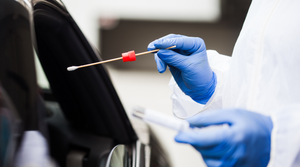Making Medical Devices Antimicrobial with Coatings
January 15, 2014
As many as one in 20 U.S. patients acquire infections during hospital stays, according to the Centers for Disease Control and Prevention. But antimicrobial material coatings are enabling new infection-fighting strategies when it comes to medical devices.
To help hospitals fight off infection, device makers have turned to metals with antimicrobial properties such as silver and copper. Medtronic highlighted another antimicrobial strategy recently, in its acquisition of the startup Tyrx: the use of antibacterial envelopes that fit around implantable medical devices.
Another example can be found in the form of antimicrobial coatings that can be applied on everything from catheters to medical electronics.
To learn more about such coatings, MPMN reached out to Rakesh Kumar, vice president technology, Specialty Coatings Systems (Clear Lake, WI), who is speaking on the subject at the upcoming MD&M West conference and expo.
Specialty Coating Systems has developed a coating known as microRESIST, which utilizes Parylene polymers. The company claims microRESIST has proven to be effective against a spectrum of microbes.
Hear Rakesh Kumar, vice president technology, Specialty Coatings Systems, deliver a presentation on antimicrobial medical device development on Thursday, February 13, at MD&M West in Anaheim, CA. |
MPMN: Could you explain how microRESIST was developed and how it works? Could you also provide some examples of applications where the coating can be used?
|
Suitable for use on a variety of medical devices, the microRESIST coating has demonstrated a more than 5 log decrease of 14 common microorganisms after 24 hours. |
Rakesh Kumar: Healthcare providers are continually tasked with improving patient health while reducing the risk of infection. Pathogens that cause healthcare-associated infections (HAIs) pose an ongoing and increasing challenge to hospitals, both in the clinical treatment of patients and in the prevention of the cross-transmission of these problematic pathogens. HAIs result in more deaths than AIDS, auto accidents, and breast cancer deaths combined in U.S. hospitals. This has led to an increased interest in antimicrobial protection for devices in continuous contact with patients. As a result, manufacturers are looking to antimicrobial coatings that are biocompatible, biostable, and non-toxic that can meet FDA compliance rules.
Since commercially available Parylenes can meet all the requirements for medical applications except antimicrobial aspects, SCS took the challenge and achieved a significant breakthrough by successfully developing microRESIST antimicrobial Parylene technology. This technology combines the benefits of Parylene with antimicrobial properties to effectively eliminate harmful microorganisms on coated medical devices and components, including catheters, urological tools, medical electronics, and other devices that come in contact with body. microRESIST antimicrobial Parylene technology offers more than log 5 (99.999%) reduction against 14 microbes after 24 hours of inoculation.
MPMN: How does the microRESIST coating compare to other SCS coatings intended for medical devices in terms of its ability to withstand common sterilization techniques?
Kumar: Medical devices coated with microRESIST antimicrobial Parylene technology are well suited for most commonly used gamma radiation and ethylene oxide sterilization techniques. We have not yet evaluated microRESIST's ability to withstand E-beam, steam and H2O2 plasma sterilization techniques.
MPMN: Could you briefly explain the other benefits of Parylene coatings for medical devices with respect to their ability to improve biocompatibility, prevent material leaching, lubricity, and so forth?
Kumar: SCS Parylenes N, C, and Parylene HT comply with biological testing requirements for ISO 10993 and are certified to comply with the biological testing requirements for USP Class VI Plastics. The results of these biological studies are maintained in SCS' FDA Device and Drug Master Files, which are available for reference by SCS commercial coating service customers.
Parylene coatings are excellent moisture and chemical barriers for medical device components. Applied much thinner than alternative coatings, Parylene provides a pinhole-free barrier to protect against body fluids as well as moisture, chemicals, and common gases. The coatings also prevent the leaching and extracting of materials.
Parylenes also have excellent dielectric properties. Their high dielectric strength is attributable to the fact that they can be formed as thin, continuous, and uniform films free from defects and the fillers commonly found in conventional coatings, both of which tend to reduce dielectric strength.
Finally, Parylene coatings possess excellent dry-film lubricity characteristics, with a coefficient of friction nearing that of PTFE.
MPMN: In light of growing antimicrobial resistance, what advice would you give to medical device engineers looking to curb the infection risk of their products. What advice would you give to makers of implants specifically?
|
A variety of surfaces can be contaminated in modern hospitals. Image from Wikipedia. |
Kumar: My advice to medical device engineers would be to evaluate microRESIST technology on their products and assess its suitability considering various attributes of Parylene technology (such as biocompatibility, dry lubrication, chemically inert, etc.) to curb the infection risk. For implant manufacturers, our recommendation is to test microRESIST effectiveness against their target microorganisms first and then evaluate its suitability per their required tests for implants. Due to the vapor phase polymerization process, mircroRESIST antimicrobial Parylene technology has ability to coat many miniaturized devices and penetrate into areas on devices where liquid coatings cannot reach, enhancing the performance reliability.
MPMN: What advances in the field of antimicrobial medical devices do you foresee in the future--both in the near term and 5-10 years down the road?
Kumar: I do see new organic antimicrobial agents being incorporated into medical devices to address the growing issues of infections. The near term challenge is to broaden the application of known and established antimicrobial options to medical devices by evaluating their suitability and safety of the products. However, new antimicrobial materials and their applications would be needed to address the issues of antimicrobial resistance and such developmental activities would be the focus for the next 5-10 years.
MPMN: Medtronic recently acquired Tyrx, a maker of an antimicrobial envelope that fits around a number of medical devices. What are your thoughts on the strategy that Tyrx uses in their devices, which is to embed an antibiotic drug into an envelope?
Kumar: There are many types of antimicrobial options in development and/or on the market and manufacturers should evaluate those that meet the needs of their products.
About the Author(s)
You May Also Like




